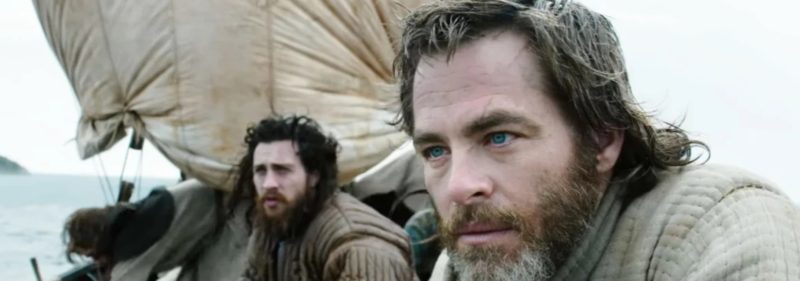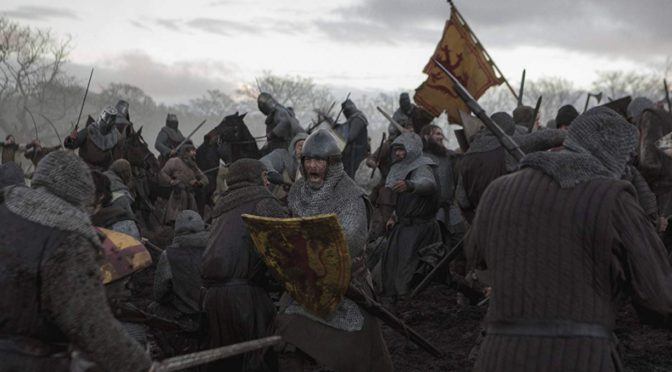The shadow of BRAVEHEART looms over OUTLAW KING, regardless of whether your reaction to Mel Gibson’s 1995 epic was positive or negative. It is the giant, woad-painted elephant in the room. OUTLAW KING, however, more or less skips over that film in two lines of contextual opening subtitles, eager to put its own cinematic stamp on Scottish history (one that seems very much influenced by Game of Thrones). David Mackenzie’s Netflix film – getting a theatrical release at the Filmhouse in Edinburgh and Glasgow Film Theatre after a festival run – is paced oddly at times, with an uneven script, but is certainly ambitious in vision and less focused on ahistorical absurdities.
Chris Pine leads as Robert The Bruce, linking up with Mackenzie as he did for HELL OR HIGH WATER, chronicling the life of Scotland’s king from shortly after most of the Scottish nobility pledge fealty to ‘Hammer of the Scots’, Edward I (Stephen Dillane). Florence Pugh, of LADY MACBETH, plays his new wife Elizabeth de Burgh, alongside a host of supporting roles covering various figures in Scottish and British history. Chief amongst them are probably Aaron Taylor-Johnson’s James ‘Black’ Douglas, who has his ancestral lands wrenched from his bloodline by Edward I, and Prince Edward (Billy Howle), with the latter framed as Bruce’s primary nemesis.
Mackenzie opens with what seems like a single long take establishing many characters in a camp outside the besieged Stirling Castle. Although there is not necessarily the most dramatic of framing within this sequence, it does help to establish all these characters as a cohesive narrative whole, including a duel between Bruce and Prince Edward that nicely foreshadows their enmity. ‘Black’ Douglas is established, as is Edward I’s character in his dismissal of him, and also Bruce’s rivalry with John Comyn. This is also one of the few scenes where Chris Pine gets to display what might make him a good fit for the role. His mocking grin during the duel displays a nice balance of charisma and arrogance that he has used to great effect in the STAR TREK series, but also fits the character of Robert The Bruce quite well. A historical national hero he may be, but Bruce believed in a god-given right to his reign, as illustrated by his relationship with Comyn.
“Mackenzie opens with what seems like a single long take [which establishes] all these characters as a cohesive narrative whole…”
It is unreasonable to expect films depicting medieval history to be fully accurate (having said this, bemoaning the lack of bridge in BRAVEHEART’s Battle of Stirling Bridge is the hill I will die on). OUTLAW KING, however, has some reverence for historical context, if not necessarily the full facts. There are some nice allusions to folk stories surrounding Bruce, including the tale, oft-repeated to schoolchildren, of him witnessing a spider try and fail to build a web. In painting a hero figure, it would have been easy to omit the murder – unambiguously presented as such – of John Comyn. Outside this Bruce is presented as a more mild-mannered and selfless man than was probably the case, but given the film doesn’t shy away from some of the more ruthless aspects of his character, its unclear whether that is driven by the script or a ropier part of Pine’s portrayal.

What OUTLAW KING does lack is a well-developed pacing to build dramatic tension, arguably as a result of this desire to present this full picture. Be careful what you wish for. The film has been trimmed back since its festival run by nearly half an hour. Whether it would benefit from these additional minutes is debatable, but there are points that feel a little disjointed. A swan eating/strangling sequence with Prince Edward is particularly odd and abrupt to the point of being Python-esque, and the film definitely meanders for a while after Bruce’s men are ambushed at Methven. That same ambush scene also displays some of the best qualities of OUTLAW KING, as fiery arrows rain down on Bruce’s men in the dead of night the actual shotmaking is both beautiful and terrifying.
“…battle sequences are suitably violent and mudbound, and very much seem to be influenced by Game of Thrones. The final battle at Loudoun Hill has a very clear ‘Battle of the Bastards’ feel to it…”
The other battle sequences are suitably violent and mudbound, and very much seem to be influenced by Game of Thrones. The final battle at Loudoun Hill has a very clear ‘Battle of the Bastards’ feel to it; there is a similar muted colouring, and a sound mix balancing the low rumble of hooves with the high pitch clash of steel on shields and flesh. The myriad of characters introduced across the running time has the same headspinning range of HBO’s flagship (and includes two from that show in Stannis Baratheon actor Dillane, and Brynden ‘The Blackfish’ Tully’s Clive Russell).
There is no doubt OUTLAW KING is an engaging and well made epic. However – for better or worse – it is not redolent with the romanticism that allows historical epics to break out from their niche. There is little that captures the concept of why Scottish identity remains so strong, and why in the 1300s it was came to be represented by Robert The Bruce. Although perhaps too much to ask from a two-hour Netflix film, some indication of why he is still revered in such a way (so much so that there is even another film in the works about his life) would elevate the emotions. The good and bad of Scotland’s national character in the twentieth and twenty-first centuries has been fairly well established on film through the work of Bill Forsyth, the TRAINSPOTTING films, and even the likes of Lynne Ramsay’s RATCATCHER. When it comes to the wars of independence, as successful as OUTLAW KING is with the cinematic visuals, it will not be fulfilling that same role.

